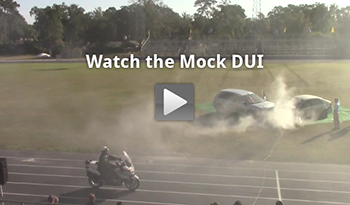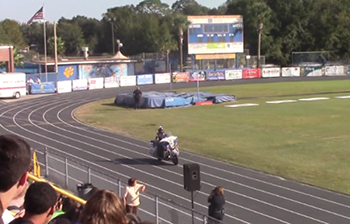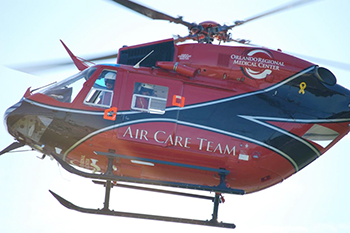Driving Under the Influence: Crash Portrayals Teach Young People the Consequences of Dangerous Behaviors Behind the Wheel - Seminole County, Florida
Note: Please view the accompanying video.
You can also view the mock DUI Noteworthy Practice webinar files.
Background
Traffic officials in Seminole County noticed that the county had a problem with teens driving under the influence. For these officials, every young life lost or changed forever from an alcohol-related driving incident was one life too many.
Traditional in-class driving safety education was not helping to get teens to think about the risks of drinking and driving once they were no longer within school walls. Traffic officials had to think bigger, to bring the education out of the classroom, and to dramatize for students the impact that drinking and driving and other risky driving behaviors would have on their friends, family, and society.
Key Challenges
The key challenge in getting a new kind of driving safety education program off the ground was in gaining support and sign-off from the following groups:
- Partner agencies, including local emergency services
- The county public school administration
- Each of the county's nine public schools
Description of Practice

The Mock-DUI program, as it was originally named, is a community-wide effort that relies on the participation of concerned citizens, local businesses, high school educators, as well first responders, including fire and police (see participants list at the end of this document). This program educates young drivers on the stark consequences of driving under the influence of drugs or alcohol and driving while texting, speeding, or not using safety belts, with a full portrayal of a crash caused by one of these dangerous behaviors.
Juniors and seniors at all nine public high schools and at one private school in Seminole County will see the portrayal once during their high school careers. Organizers try to hold the portrayal shortly before a major school event, such as Homecoming, and it is typically held on the school's athletic fields. All teenage actors are students at the school where the portrayal is held. The portrayal begins with an introduction from a member of local law enforcement, who tells students that the portrayal is not meant to scare them, but to present facts.
A young man then drives across the field to his date's house to pick her up for a dance. The couple says goodbye to her parents and promise she'll be back by midnight. They drive away. Instead of going to the dance, they go to a party. Soon there is a loud bang and smoke. Two hidden cars are revealed, wrecked; the car driven by the young man has hit another car. He is unharmed but his date has been killed and two people in the other car are badly injured—they are maimed, or have suffered brain damage. Real emergency service personnel arrive and use the Jaws of Life to remove the injured, and a Medevac helicopter lands on the field to take one of the injured to a hospital. The young man is given a field sobriety test, he is arrested, and faces decades in prison. A hearse arrives to remove the body of the young woman.

For the rest of the day, the actor playing the arrested young man is not in school, while a single rose is placed on the desk of the actress playing the young woman who was killed.
Results
Local trends show fewer fatalities from teens driving under the influence since the program began in 2002. There is also anecdotal evidence that students are more aware of risky driving behaviors. For the first 10 years of the program, Seminole County traffic officials received written summaries from teens who had watched the portrayal, to understand how much they learned, retained, and how the program could be tweaked. Transportation officials drew on this deep knowledge pool to improve the program and build on past successes. The program grew to include more law enforcement and emergency personnel and more vehicles so that the portrayal would most accurately reflect a real crash.
A mother recently told Seminole County transportation officials that her daughter had put the lessons learned to good use. Days after a portrayal her daughter went to a dance and noticed that a friend who was supposed to drive her home was acting strangely. She did not get in the car, and that friend crashed. The mother appreciated that her daughter had absorbed the lessons from the Seminole County risky driving portrayal.
Benefits Realized
The primary benefits have been greater student engagement in thinking about risky driving behaviors, and improved multi-agency training. The creators of the risky driving portrayal program have developed a template for staging the enactment. Several counties and schools districts have contacted Seminole County to learn about bringing the program to their students.
Community Participation in the Mock DUI Event
Local Citizens:

- John and Sally Shepard - Brain injury survivors
High Schools:
- Seminole County Public Schools:
- Crooms Academy
- Hagerty High
- Lake Brantley High
- Lake Howell High
- Lake Mary High
- Lyman High
- Oviedo High
- Seminole High
- Winter Springs High
- Trinity Preparatory School
Businesses:
- Baldwin-Fairchild Funeral Home
- C&S Towing
- AAA/Auto Club South
- MTRecycling
- Nationwide Insurance
Agencies:
- Altamonte Springs Police Department
- Casselberry Police Department
- Casselberry Fire Department
- Lake Mary Police Department
- Lake Mary Fire Department
- Longwood Police Department
- Longwood Fire Department
- Oviedo Police Department
- Oviedo Fire Department
- Sanford Police Department
- Sanford Fire Department
- Winter Springs Police Department
- Florida Highway Patrol
- Seminole County Fire Department
- Seminole County Sheriff's Office
- Seminole County State Attorney's Office
Contact
Robin Butler
Seminole County Fire Department
407-665-5641
rbutler@seminolecountyfl.gov

